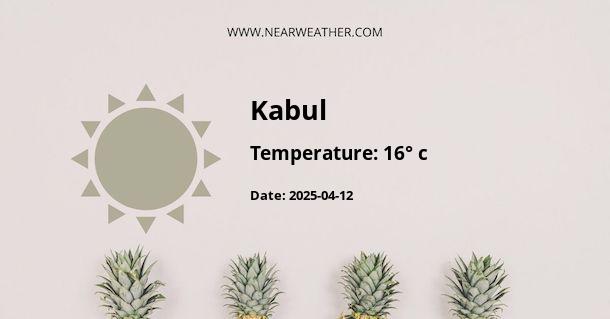The Climate and Weather in Kabul, Afghanistan
Kabul, the capital city of Afghanistan, is located in the eastern part of the country and experiences a continental climate. Situated at an altitude of 1,800 meters (5,900 feet) above sea level, Kabul's weather is influenced by its high elevation and its location in the central highlands of Afghanistan.
Seasonal Overview
Kabul experiences four distinct seasons: spring, summer, autumn, and winter. Each season brings its own unique weather conditions and temperature variations.
Spring (March to May)
Spring in Kabul is characterized by gradually warming temperatures and the blooming of flowers and trees. The average daily temperature in March is around 11°C (52°F) and gradually increases to 20°C (68°F) in May. Spring is also the wettest season in Kabul, with occasional rain showers and thunderstorms.
Summer (June to August)
Summer in Kabul is hot and dry. The average daily temperature ranges from 25°C (77°F) to 35°C (95°F), with occasional heatwaves pushing temperatures even higher. The city experiences very little rainfall during this season, and the days are generally sunny and clear.
Autumn (September to November)
Autumn in Kabul is characterized by mild temperatures and beautiful foliage as the leaves on the trees change colors. The average daily temperature in September is around 21°C (70°F) and gradually decreases to 11°C (52°F) in November. The season is relatively dry with occasional gusty winds.
Winter (December to February)
Winter in Kabul is cold and snowy. The average daily temperature in December is around 3°C (37°F) and drops to -2°C (28°F) in January. The city experiences significant snowfall during this season, with snow-covered landscapes becoming a common sight. However, the days are often sunny, and the snow tends to melt quickly.
Temperature and Rainfall
The climate in Kabul is characterized by a large temperature variation between day and night throughout the year. Summers are hot during the day, but nights can be significantly cooler. Winters are cold, and temperatures often drop below freezing at night.
The annual average temperature in Kabul is around 13°C (55°F). The hottest month is typically July, with an average temperature of 29°C (84°F), while the coldest month is January, with an average temperature of -1°C (30°F).
Precipitation in Kabul is relatively low, with an average annual rainfall of around 300 millimeters (12 inches). The majority of the precipitation occurs during spring and autumn, while summer and winter tend to be dry.
Extreme Weather Events
Being located in a region prone to natural disasters, Kabul can occasionally experience extreme weather events. These events include heavy snowfall, earthquakes, and occasional flash floods during heavy rains.
Conclusion
Kabul's climate is characterized by four distinct seasons, with hot summers, cold winters, and mild temperatures during spring and autumn. The city experiences a large temperature variation between day and night, and precipitation is relatively low throughout the year. It is important for residents and visitors to be prepared for the extreme weather conditions that Kabul can occasionally experience.
A - Kabul's Latitude is 34.528130 & Longitude is 69.172333.
A - Weather in Kabul is 16° today.
A - Climate Conditions in Kabul shows clear sky today.
A - Humidity in Kabul is 43% today.
A - Wind speed in Kabul is 6.16 km/h, flowing at 49° wind direction. today.
